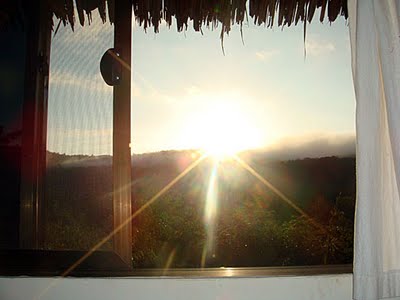 The view through my window at Rainbow Lodge at 6am this morning as the sun peered over the hills and across the river
The view through my window at Rainbow Lodge at 6am this morning as the sun peered over the hills and across the river
Just through the door at 2pm, five hours on the Virak-Buntham bus (paid $8 instead of the usual $11 that barang pay) and the end of my short but sweet
Koh Kong adventure. We (that's me and my brother Tim) left Oasis Resort on Monday morning and headed out to the village of Tatai and a one-night stop at the eco-friendly Rainbow Lodge. It was pissing down with rain so we got very wet as we paid a whistle-stop visit to the new 4Rivers Floating Eco-Lodges on the bend of the Kep River, before arriving at Rainbow. After lunch, and bedecked by brilliant sunshine, we went canoeing to the Tatai waterfalls and had an early(-ish, 11pm) night amidst the bird-calls of the surrounding forest. Quick word on the hospitality and food at Rainbow - excellent. A very enjoyable five days in the Koh Kong region, with more pictures and lengthier reports to follow.
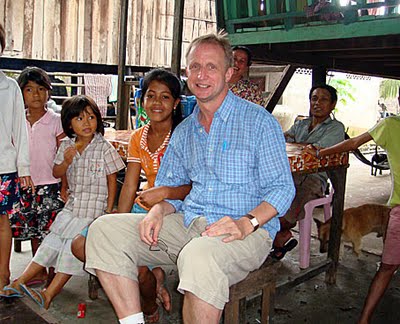 The adorable Srey Roath and me at the fishing village of Koh Kapik. We were walking through the village, she grabbed my hand and next minute, we were eating food at her mother's stall.
The adorable Srey Roath and me at the fishing village of Koh Kapik. We were walking through the village, she grabbed my hand and next minute, we were eating food at her mother's stall.
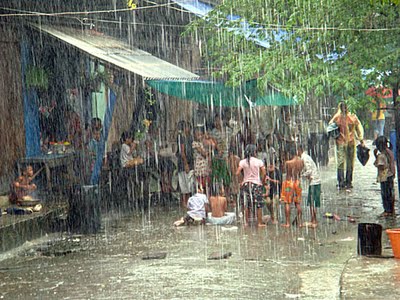 The children at Koh Kapik were great fun and this game of It's A Knockout in the pouring rain was a real joy
The children at Koh Kapik were great fun and this game of It's A Knockout in the pouring rain was a real joy
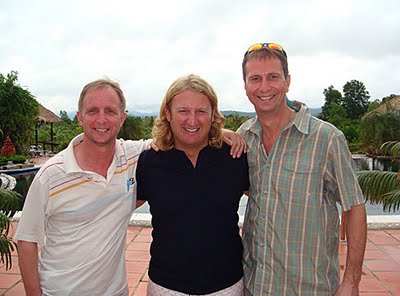 The rain stopped for a minute allowing this photo at the Oasis Resort in Koh Kong. LtoR: me, Jason (proprietor of Oasis and all-round nice-guy) and Tim.
The rain stopped for a minute allowing this photo at the Oasis Resort in Koh Kong. LtoR: me, Jason (proprietor of Oasis and all-round nice-guy) and Tim.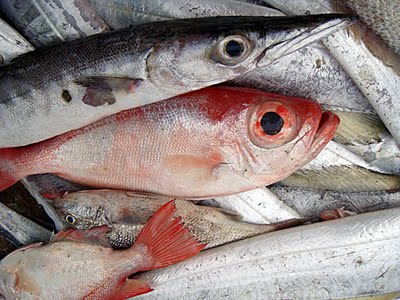 Catch of the day at the Muslim fishing village a couple of kilometres from Koh Kong town
Catch of the day at the Muslim fishing village a couple of kilometres from Koh Kong town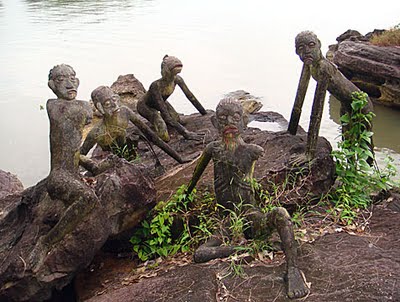 Visions of hell on the rocks at Wat Neang Khop, just over the bridge at Koh Kong
Visions of hell on the rocks at Wat Neang Khop, just over the bridge at Koh KongLabels: 4Rivers Tatai, Koh Kong, Rainbow Lodge
 The view through my window at Rainbow Lodge at 6am this morning as the sun peered over the hills and across the river
The view through my window at Rainbow Lodge at 6am this morning as the sun peered over the hills and across the river The adorable Srey Roath and me at the fishing village of Koh Kapik. We were walking through the village, she grabbed my hand and next minute, we were eating food at her mother's stall.
The adorable Srey Roath and me at the fishing village of Koh Kapik. We were walking through the village, she grabbed my hand and next minute, we were eating food at her mother's stall. The children at Koh Kapik were great fun and this game of It's A Knockout in the pouring rain was a real joy
The children at Koh Kapik were great fun and this game of It's A Knockout in the pouring rain was a real joy The rain stopped for a minute allowing this photo at the Oasis Resort in Koh Kong. LtoR: me, Jason (proprietor of Oasis and all-round nice-guy) and Tim.
The rain stopped for a minute allowing this photo at the Oasis Resort in Koh Kong. LtoR: me, Jason (proprietor of Oasis and all-round nice-guy) and Tim. Catch of the day at the Muslim fishing village a couple of kilometres from Koh Kong town
Catch of the day at the Muslim fishing village a couple of kilometres from Koh Kong town


2 Comments:
Hi Andy,
Please report on the work of Ly Daravuth, seems very interesting judging from the appreciation below. Have you seen MESSENGERS?Have you ever met Ly personally? - Thanks, Brenda Abbot
...................................
An alternative scenario for the ‘use’ of the S-21 photographs was recently provided by Phnom Penh-based artist Ly Daravuth, with assistance from Youk Chhang. Ly’s installation, MESSENGERS, was shown as part of a group show he co-curated in January 2000 in Phnom Penh, titled ‘The legacy of
absence: a Cambodian story’. The work comprised numerous photographic portraits of young Cambodians. The physical condition of the photographs, their colouring, composition and their subject matter – solemn, black-clothed girls and boys of various ages – are immediately recognized as S-21 prisoner portraits. These are portraits of children taken during the Democratic Kampuchea period, but those depicted were not prisoners of S-21. These
are portraits of children who were used to run messages between various local cadres for the regime, known as angkar (the organization). Interspersed
with these photographs are photographs of children living in
present-day Cambodia, whose portraits were taken by Ly. These photographs were composed and doctored so as to mimic the appearance of the
historical photographs. MESSENGERS questions the truth-claims made about victim photographs and documents from the Democratic Kampuchea period in contemporary Cambodia. In a cultural context in which images of S-21 victims are well known and charged with considerable emotion, Ly seeks
to interrupt the immediate recognition of victimhood. Exhibiting the historical photographs of the child messengers, whose identities are
suggested only in the title of the work (and given in the exhibition
catalogue), reminds viewers that the genocidal regime photographed its faithful cadres as well as its incarcerated enemies. The installation questions the designation of victim-survivor status, especially by non-
Cambodians of Cambodians, but also by Cambodians of themselves:
"For the young who come after and have no direct connection to such terrible events, the images of what happened can become the vocabulary by which to construct that all too seductive position of ‘I am Cambodian and therefore a
victim’." (Ly and Muan, 2000)
Ly Daravuth and Ingrid Muan observe that some Cambodian artists who were very young during the Democratic Kampuchea period ‘investigate
without reverence what it means to live in partial memories’ (Ly and
Muan, 2000). In addition to this work, Ly and Muan note work in which refusing to testify is offered up as a way of living with the past. Little such space is opened for any of these memorializing stratagems – the refusal of victimhood, the refusal to testify, or the active questioning of the truthartefact
– in the 1997 MoMA exhibition.
(Rachel Hughes, "The abject artefacts of memory: photographs from Cambodia's genocide")
Great I used to be one time at Ranbow resort in Koh Kong. I like so much
Post a Comment
<< Home